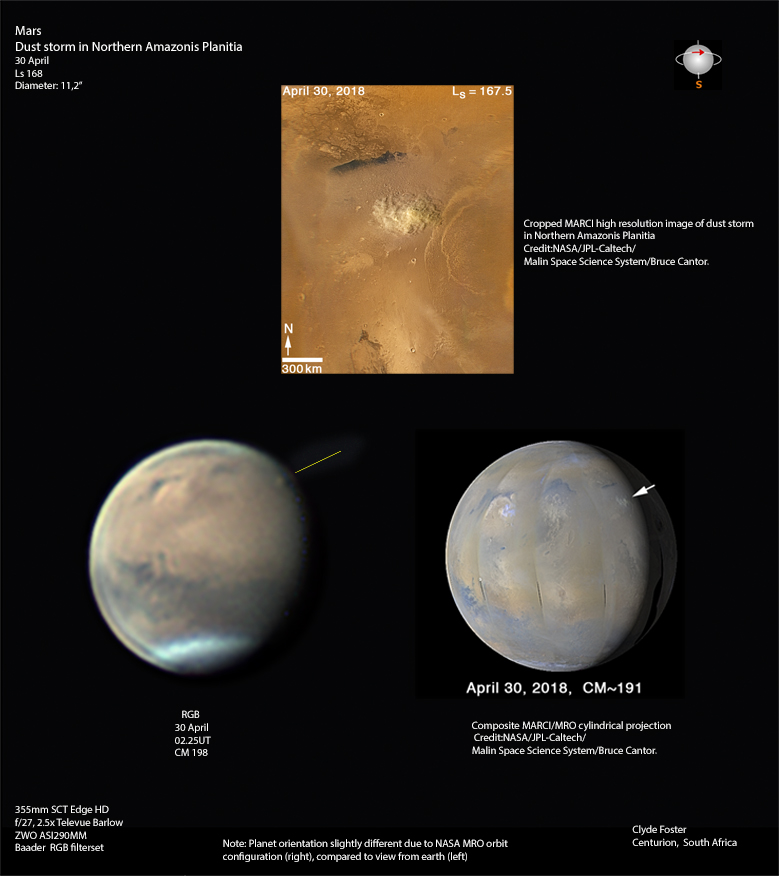
Mars Image 2018/05/03(UT)
Clyde Foster,Paul Maxson
C.Foster,P.Maxson

| Clyde Foster |
Mars image set from 3 May. Pity about the edge artefact,but submitting for the record. OM nicely see,and apparently cloudless. I believe it would be Arsia Mons that is coming into view on the terminator with afternoon cloud visible.As some of you may have seen in recent communications,I have been somewhat intrigued by a small, bright feature,adjacent to the terminator,in the northern Amazonis Planitia region,that I imaged on 30 April. I had initially thought it was the summit of Olympus Mons,as there are no other significant features in the vicinity. However,on detailed checking of the co-ordinates (approx. Lat +30,Long 150), it was clear that it was,although close by,not the giant volcano. The feature was brightest in R,and just detected in IR and G,but not in B,which,following some online discussion, pointed to a possible small dust event. On capturing a “duplicate” image on 2 May,no feature was detectable, which also seemed to strengthen the view that the original bright spot may have been a local,condensed,transient dust storm. I had been privileged to meet Dr Michael Ravine of Malin Space Science Systems(MSSS) at EPSC 2017 in Latvia, and I had mentioned to him how much I appreciated the weekly online reports (http://www.msss.com/msss_images/latest_weather.html) from the MARCI imaging system onboard the NASA Mars Reconnaissance Orbiter(MRO),which has been in orbit around Mars since March 2006. MSSS are responsible for,amongst others,the MARCI imager,and the management, download and processing of imagery from the instrument on behalf of NASA. Out of interest,I forwarded a copy of my images to him,and was pleasantly surprised to get a response from one of his co-workers, Dr Bruce Cantor,who is the MSSS inhouse Mars atmospheric Scientist and deputy principle Investigator for the MARCI instrument onboard the MRO. Dr Cantor very kindly forwarded me a global,simple cylindrically projected MARCI/MRO map of Mars from 30 April, and to my amazement and delight,it clearly showed a bright,condensed, dust storm exactly in the location that I had imaged the bright spot(the storm is the one at far left on the Map, with Olympus Mons just to the lower right of it). He subsequently sent me a MARCI composite Mars image, which I have compared directly with my own image. Unlike normally,I have put my image with north at top,to allow the comparison. Planetary orientation of the two images is slightly different due to the orbital configuration of the MRO. Further,he very kindly sent me an amazing,high resolution (1 km/pixel),cropped MARCI/MRO image of the storm. Some details regarding the storm (with thanks to Dr Cantor and referring to the high resolution MARCI/MRO image): “The Storm covers an area of approximately 154,000 km^2. For reference,the bright spot in the centre of the storm is at 29.9 N,153.2 W, north is up and west longitude increasing from right to left across the projection. The top of the image is Arcadia Planitia and Olympus Mons is on the far right. The bright spots just to the north and northwest of the storm (south of the large dark albedo feature,Euxinus Lacus) are the large Amazonis dust devils that are typically observed during the northern summer season.” As far as my own image is concerned,if the storm had been in full sunlight,a short while earlier, it would very likely have made it significantly more difficult to detect due to reduced contrast. Similarly,a short while later,it would have rotated into darkness,so the timing of my image of the 30 April, appears to have been just perfect- an amazing co-incidence. My sincere appreciation to Dr Michael Ravine and Dr Bruce Cantor of Malin Space Science Systems for the interaction on this issue, and giving permission for me to share the above information. All images other than my own,are credited to Bruce Cantor (MSSS): NASA/JPL-Caltech/Malin Space Science Systems

[Clyde Foster:Centurion,South Africa]
| Paul Maxson |
Below average.[ Paul Maxson:Surprise,Arizona,United States]
 ALPO-Japan Latest ALPO-Japan Latest

 Mars Section Mars Section
2018/05/04
| 2018/05/02
| |